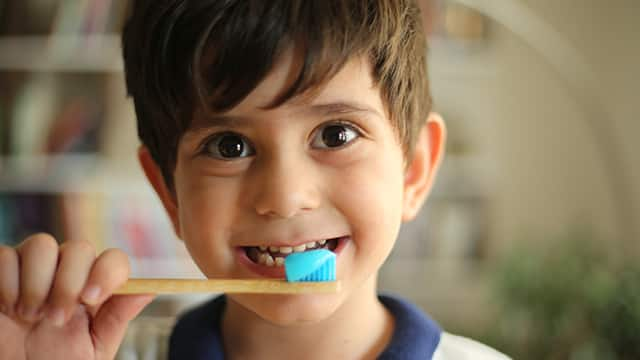Getting children excited about brushing their teeth without a fuss? For many parents, that feels like winning a small battle every morning and night. But here’s the thing, oral hygiene doesn’t have to be a struggle. With the right tricks, you can turn tooth brushing into a fun, engaging routine that your kids actually look forward to. And along the way, they’ll pick up good oral habits that will keep their smiles healthy and ensure they have strong teeth.
Incorporate Music, Videos, Stories, and Games1
Kids love games, and tooth brushing can easily become one. Try a two-minute bubble challenge: who can create the most foam before the timer goes off? You can also add music or play an upbeat song your child loves, or play a short, fun video while they brush.
For more imaginative kids, bring in storytelling. Make the toothbrush a superhero on a mission to fight “sugar bugs,”2 or use a toothbrush from Colgate featuring their favorite cartoon character, like Batman or the Minions, to make the process feel like an adventure. When brushing becomes part of a game, kids often forget it was “a chore” to begin with.
Let Them Pick Their Own Tools3
Children feel more ownership when they choose what they use. Take them shopping in-store or online and let them select their toothbrush. Bright colors, flashing lights, or character-themed handles instantly make brushing more appealing.
And don’t forget toothpaste. The Colgate Kids range has options that suit different needs and preferences, from cavity protection toothpaste to fluoride-free formulas with no artificial colors or preservatives, which makes them suitable for children’s dental care routine. Giving kids a choice makes brushing feel less like a rule and more like their own decision.
Brush Together as a Family4
Kids learn most from what they see. If they see you taking your dental health seriously, they’re more likely to follow suit and treat it as a normal part of life rather than a chore that only the little ones have to do. Stand together at the sink, brush at the same time, and yes, make silly faces in the mirror.
Brushing together also lets you subtly check their technique. Are they reaching the back teeth? Are they brushing for a full two minutes? When children see parents and older siblings caring for their teeth, it reinforces the idea that oral hygiene is for everyone, at every age.
Reward Good Oral Hygiene Habits5
Positive reinforcement works wonders. A reward system can help keep kids on track. But instead of always giving tangible rewards, mix it up. Sure, stickers and star charts are great, but so is letting your child choose the bedtime story, pick the family movie, or stay up an extra 15 minutes on weekends. Small, consistent rewards help children associate brushing and flossing with positive outcomes rather than seeing it as a chore6.
Celebrate their effort, not just the result. A high-five for consistency, a hug for remembering without a reminder, these moments build motivation. Over time, brushing and flossing will feel as routine as washing hands before a meal.
Switch Up the Routine Occasionally
Kids can get bored quickly. So, every now and then, change something. A new toothbrush color, a different song, a weekend brushing session outdoors (yes, even on the balcony with a glass of water and a spittoon cup). Small surprises keep the habit fresh and prevent it from feeling repetitive.
Frequently Asked Questions
What to do if toddlers refuse to brush their teeth?
Make it a ritual, not a command. Instead of asking “Do you want to brush your teeth?”, which invites a “no”, try “Which toothbrush are we using tonight?” Lay theirs next to yours so they see it as part of the family’s routine. Toddlers love mimicking, so let them “help” you first, then trade7.
When should kids start flossing?
As soon as two teeth touch, usually between ages 2 and 3. At this stage, you’ll need to do the flossing for them. Always check with your dentist for technique tips suited to your child’s needs.8
Should Kids Floss or Brush First?
Floss before brushing. Research shows flossing first removes more plaque, allowing the fluoride in toothpaste to better coat the teeth afterward.9






